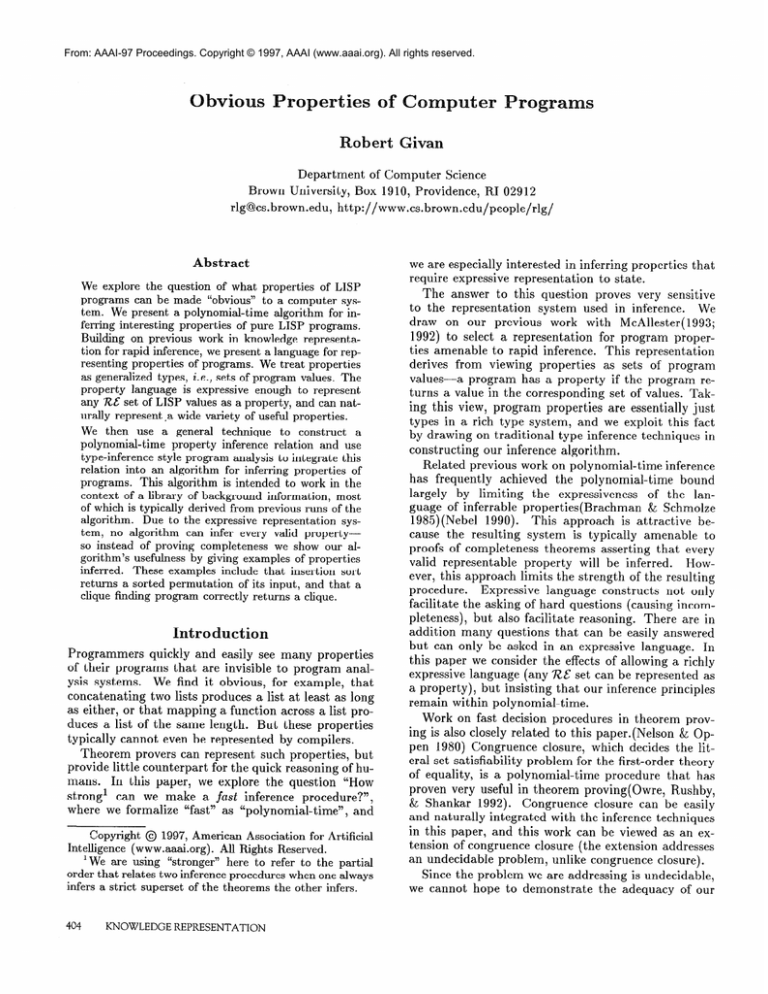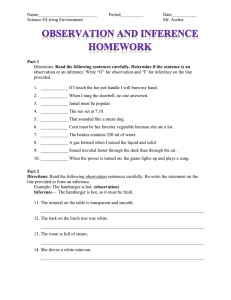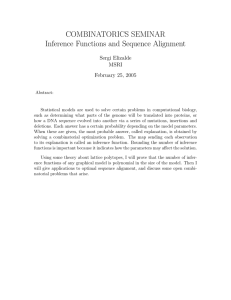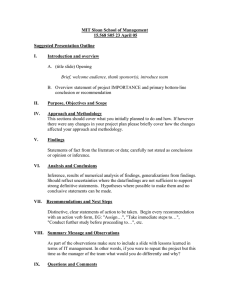
From: AAAI-97 Proceedings. Copyright © 1997, AAAI (www.aaai.org). All rights reserved.
Obvious
erties
Robert
sf Co
uter
Programs
Divan
Department
of Computer
Science
Brown University,
Box 1910, Providence,
RI 02912
rlg@cs.brown.edu,
http:// www.cs.brown.edu/people/rlg/
Abstract
we are especially
We explore the question of what properties
of LISP
programs can be made “obvious” to a computer system. We present a polynomial-time
algorithm for inferring interesting
properties
of pure LISP programs.
Building
on previous work in knowledge representation for rapid
inference,
we present
a language
for representing
properties
of programs.
We treat
properties
as generalized
types,
i.e., sets of program
values.
The
property
language
is expressive
enough
to represent
any RE set of LISP values as a property,
and can naturally
represent
,a wide variety
of useful
properties.
We then
use
a general
technique
to construct
a
polynomial-time
property
inference
relation
and use
type-inference
style
program
analysis
to integrate
this
relation
into
an algorithm
for inferring
properties
of
programs.
This
algorithm
is intended
to work
in the
context
of a library
of background
information,
most
of which
is typically
derived
from
previous
runs of the
algorithm.
Due to the expressive
representation
system,
no algorithm
can infer
every
valid
propertyso instead
of proving
completeness
we show
our algorithm’s
usefulness
by giving
examples
of properties
inferred.
These
examples
include
that
insertion
sort
returns
a sorted permutation
of its input, and that a
clique finding
program
correctly
returns
a clique.
Introduction
Programmers
quickly
and easily see many properties
of their programs
that are invisible
to program
analysis systems.
We find it obvious,
for example,
that
concatenating
two lists produces
a list at least as long
as either, or that mapping
a function
across a list produces a list of the same length.
But these properties
typically
cannot even be represented
by compilers.
Theorem
provers can represent
such properties,
but
provide little counterpart
for the quick reasoning
of humans.
In this paper,
we explore
the question
“How
strong1
can we make a fast inference
procedure?“,
where we formalize
“fast” as “polynomial-time”,
and
Copyright
@ 1997, American
Association
for Artificial
Intelligence
(www.aaai.org).
All Rights
Reserved.
I We are using
“stronger”
here
to refer
to the partial
order
that relates
two inference
procedures
when one always
infers
a strict
superset
of the theorems
the other
infers.
404
KNOWLEDGE
REPRESENTATION
require
expressive
interested
in inferring
representation
to
properties
that
state.
The answer to this question
proves very sensitive
to the representation
system used in inference.
We
draw
on
our
previous
work
with
McAllester(l993;
1992) to select a representation
for program
properties amenable
to rapid inference.
This representation
derives from viewing
properties
as sets of program
values-a
program
has a property
if the program
returns a value in the corresponding
set of values. Taking this view, program
properties
are essentially
just
types in a rich type system, and we exploit this fact
by drawing
on traditional
type inference techniques
in
constructing
our inference
algorithm.
Related
previous
work
on polynomial-time
inference
has frequently
achieved
the polynomial-time
bound
largely
by limiting
the expressiveness
of the language of inferrable
properties(Brachman
& Schmolze
1985)(Nebel
1990).
Th is approach
is attractive
because the resulting
system is typically
amenable
to
proofs of completeness
theorems
asserting
that every
valid representable
property
will be inferred.
However, this approach
limits the strength
of the resulting
procedure.
Expressive
language
constructs
not only
facilitate
the asking of hard questions
(causing incompleteness),
but also facilitate
reasoning.
There are in
addition
many questions
that can be easily answered
but can only be asked in an expressive
language.
In
this paper we consider the effects of allowing
a richly
expressive language
(any 7U set can be represented
as
a property),
but insisting
that our inference principles
remain within polynomial-time.
Work on fast decision procedures
in theorem
proving is also closely related to this paper.(Nelson
& Oppen 1980) C on g ruence closure, which decides the literal set satisfiability
problem for the first-order
theory
of equality,
is a polynomial-time
procedure
that has
proven very useful in theorem
proving(Owre,
Rushby,
& Shankar
1992).
Congruence
closure can be easily
and naturally
integrated
with the inference techniques
in this paper, and this work can be viewed as an extension of congruence
closure (the extension
addresses
an undecidable
problem,
unlike congruence
closure).
Since the problem
we are addressing
is undecidable,
we cannot hope to demonstrate
the adequacy
of our
inference
algorithm
with a completeness
theorem.
Instead, we give examples
of the kind of properties
we
can hope to infer with this algorithm.
Unfortunately,
but intrinsically,
we do not have a clean characterization of the set of inferrable
properties-the
demand
for such a characterization
is one of the fetters we are
throwing
aside in search of stronger
fast inference.
Nevertheless,
it is important
to have some means of
The examples
contained
evaluating
our procedures.
herein are just a start-we
envision and desire the development
of a large corpus of such examples
of programs and associated
inferrable
properties.
Of course,
for any such corpus there is a constant
time algorithm
that infers all the listed properties-what
we really desire is a large corpus that can be handled
by a single
relatively
simple polynomial-time
algorithm.
The algorithm
we present below is intended
only as a start
in this direction-we
believe more inference
principles
will need to be added to it to achieve the desired generality.
Still, this algorithm
gives interesting
results
on the examples exhibited,
and was not designed with
them specifically
in mind.
Our primary
intent is to
convince the reader that an algorithm
of this sort can
make interesting
progress in the undecidable
domain of
general purpose property
inference,
and do so within
polynomial-time.
Languages
(define
(if
(define
(if
(define
(if
The programming
language
Prsgram
Expressions
we analyze is a typed, first-order,
pure subset of LISP.
It is “first-order”
because, to ease the presentation,
it
does not include
first class functions-user
functions
are introduced
through
definitions
and used only by
this work generalizes
natubeing applied-however,
rally to first class functions.
The language is “typed”
because it requires each variable
to be given a user provided type at its introduction;
these types are given in
an expressive property
language and can capture much
about the programmer’s
intended
use for the variable.
Program
expressions
are defined inductively
as follows:
1 (let
1 (if
2:e
e :
p*
el)
1 (f el -m-e,)
el
ea)
1 ‘sym
where z can be any variable,
f can be cons, car, cdr,
or any n-ary program
function-symbol,
sym can be any
symbol and p* must be a testable property
(see below).
The intended
meanings
for the above program
expressions should be clear from LISP, except that the if
tests are new: e :p is true if the value e satisfies the
Example
program
in figure 1.
(insert
x:(a-number)
l:'nil
(cons
x 1)
(if
x:0=
(car
1))
(cons
x 1)
(cons
(car
1)
(sort
1:'nil
1
(insert
(car
1)
n:(car
c:(cons
(if
(insert
x (cdr
(cdr
li:(a-list)
(largest-clique-in
s:'nil
'nil
(let
l:(a-sorted-list))
(sort
ll):(a-member-of
(car
11)
(intersect
(intersect
(cdr
(define
(if
expressions
l>>>>>>
l:(a-numlist))
(intersect
1l:'nil
'nil
(if
(car
(cons
hr
rograms
and
We introduce
the programming
language and our representation
for properties.
We give as examples
the
program
definitions
of insertion
sort and of a clique
finding
algorithm,
and the property
definitions
of a
permutation
of a list, a sorted list, and a clique.
In
the next section we describe a polynomial-time
algorithm that infers relationships
between these programs
and properties
(e.g. that sort permutes
its input).
e **..- z
property
p (see below).
appear in the definitions
1)))))
12:(a-list))
12)
(cdr
11)
11)
12))))
12))
s:(a-list>>
s>
n
(largest-clique-in
(intersect
c':(largest-clique-in
(length
c>:(>=
(neighbors
(cdr
s>>>>
(cdr
s>>>
c'>>
(length
n>
L,,,
(define
(if
(delete
l:'nil
(if
x:(a-thing)
l:(a-list))
'nil
x:(car
(cdr
(cons
11
1)
(car
l>
(delete
x
(cdr
1))))))
Figure 1: Example
program
defini&ions.
We omit
simple definitions
which have no effect on the example
inferences
claimed later (length,
neighbors)
Property
Expressions
Our property
language
is
derived from our previous work with McAllester(
1992)
on natural
language
syntax
and its relationship
to
tractable
inference.
The representational
features introduced
in that work have never before been exploited
in an automated
reasoning
system. Our property language
is essentially
the programming
language
extended
by some new constructs
that allow and facilitate the quantifier-free
construction
of sets of values.
The most important
of these constructs
is nondeterWe use nondeterminism
for its declarative
minism.
value only-property
expressions
are not programs
to
be run.
A property
expression
has in general many
possible
values via nondeterminism-the
set of these
values is the type (property)
represented
by the expression. Using recursion,
property
expressions
can denote
AUTOMATEDREASONING
405
infinite
sets.
Nondeterminism
is introduced
by the one-of
combinator2.
The expression
(one-of
s t) where s and t
are property
expressions
denotes the nondeterministic
choice between s and t. Alternatively,
one-of
can be
viewed as the union operator
on sets-(one-of
s t) denotes the union of the types (properties)
represented
by
s and t. As an example,
consider the property
a-list
in figure 2, which denotes the set of all finite LISP lists.
Nondeterminism
further
enhances
the representational power of our property
language when considered
in conjunction
with function
application.
Consider the
expression
(2* (a-number)
1. This expression
denotes
the set of even numbers.
This meaning
can be derived
by evaluating
the expression
nondeterministically3first, the argument
to 2* returns
an arbitrary
natural
number,
then 2* deterministically
doubles
this number; the result can be any even number.
A similar
nondeterministic
evaluation
applies
if we replace
2*
with a nondeterministic
“property
function”
such as
greater-than
(see figures 2 and 3 for examples).
(define
(a-permutation-of
l:(a-list))
(if 1:'nil
1
(let x:(a-member-of
1))
(cons x (a-permutation-of
(delete
x 1))))))
(define
(a-sorted-list)
(one-of
'nil
(let l:(a-sorted-list)
(cons (all-of
(>= (every
(a-member-of
(a-number))
1))))
(define
(neighbor-of
n:(a-thing))
(a-member-of
(neighbors
n)>>
(define
(a-clique)
(one-of
'nil
(let c:(a-clique))
(cons (a-neighbor-of
(every
(a-member-of
c)))
cl>>>
Figure
(define
(a-list)
(one-of
'nil
(cons
(a-thing)
(a-list))>)
(define
(a-member-of
l:(a-list))
(if 1:'nil
I
(one-of
(car 1) (a-member-of
(cdr 1))) >>
** natural
numbers (in unary)
idefine
(a-number)
(one-of
'nil
(cons ‘a (a-number>)>>
*I any list
of numbers
idefine
(a-numlist)
(one-of
'nil
(cons (a-number)
(a-numlist))))
;; the numbers >= x
(define
(>= x:(a-number))
(one-of
x (cons 'a (>= x>>)>
3: More
Example
2: Example
Property
P ::= II:
I (let
z:PPl)
A final__ representational
feature of our property
language allows the quantifier-free
construction
of properties that would traditionally
require quantifiers.
Given
a (deterministic
or nondeterministic)
function
f of one
argument,
and a property
expression
p, the expression (f (every
p) > is analogous
to the ordinary
application
(f p) except that only output
values that
can be produced
for every value p might return
are
kept. In other words, (f (every
p) > denotes the set
of values that are f-related
to every value of p. As a
2one-of
is closely related to amb introduced
by McCarthy in (McCarthy
1967)
31fyou have trouble understanding
the intended meaning ofany ofourproperty
definitions, we recommend trying
this evaluation strategy.
406
KNOWLEDGEREPRESENTATION
I (if
I (fPr%)
Definitions
Properties
more concrete example,
the notion
of a common factor of the numbers
in a set s could be represented
by
the property
(factor-of
(every
(member-of
s))).
This construction
was introduced
in (McAllester
& Givan 1992), and is inspired
by the English
noun phrase
construction
“loves every man”.
Its use in program
analysis is new and essential-it
allows the quantifierfree definition
of useful properties
like “sorted list” and
facilitates
the reasoning
about these properties
(other
representations
of these properties
are more unwieldy,
making the resulting
inference
task more difficult).
Formally,
property
expressions
are defined as:
1 (notp)
P1:P2
4233 P4)
I (4 (everw))
I (one-ofs)
Figure
1)))
I (all-of
I
'sym
1 I
S)
I (a-thing)
where f can be cons, car, cdr, or any defined program
or property
function
symbol,
sym any symbol, and s
is a finite set of property
expressions.
Note that every program
expression
is also a property
expressionwhen used as a property
expression
a program
expression denotes the singleton
set containing
the value of
the program.
This BNF includes some expressions
not
yet mentioned:
(all-of
s) denotes those values that
are possible
values of every expression
in s, (not p>
denotes those values that are not possible values of p,
I denotes the empty set of values, and (a-thing)
denotes the set of all possible values (quoted
symbols or
finite cons expressions
built up from them).
Programs
We consider a sequence of function-symbol definitions
to be a program.
A function-symbol
definition
assigns to a new function-symbol
either
of
p) or (fix
f xl:pl,-s-,x,:
(lambda
~1 :pl, - - - ,x,:pn
l)n p) where the body p must be deterministic
(i.e.
a program
expression)
if the symbol being defined is
a program
function-symbo14.
The properties
pj can
reference
and depend
on the variables
~1, . . . , ~:j - 1.
Note that we differentiate
between program
functionsymbols and property
function-symbols.
Semantics
and Other
Issues
We have a complete
and detailed
semantics
for the above languages
that
will be presented
in the full version of this paper.
We note that the expression
(f (every
e) > for
program
expression e has the same meaning
as the expression
(f e) . We will treat these two expressions
as
identical,
even in the pattern
matching
used in applying the inference
rules given later:
so the expression
(f e) will match the pattern
(R (every
s) ) with f
instantiating
R and e instantiating
s.
Also, we have left unresolved
above the issue of how
to execute a program
containing
an if expression
that
tests a nondeterministic
property.
This peripheral
issue is handled in detail in the full version of the paper;
here we only comment
that we require the user to provide a verified implementation
of any nondeterministic property
function
used in an if test in a program
function
definition-this
task is straightforward
for the
examples given in this paper.
We refer to a property
so implemented
as testable.
An
Inference
Algorithm
Our inference algorithm
accepts as input a new definition (of a program
function
or a property
function)
and
a background
library
of type theorems, and produces as
output
some new type theorems
about the newly defined symbol that are then added to the background
library. By “type theorem”
we mean a universally
quantified formula
of the form f oral1
xl:pl.
- - x,:pn
. p:
p’ where p will typically
involve the new symbol and p’
is viewed as a type or property
being asserted about p.
Figure 4 shows example type theorems produced
in analyzing the example programs
shown earlier.
Throughout this section we assume we are analyzing
a definition
assigning
the lambda or fix expression
e to the new
function
symbol g, with respect to background
library
,C (in particular,
e will appear as a subscript
on our
inference relation
symbols l-e and l--oe to indicate
their
dependence
on e).
Definition
erates very
Analysis
An initial
useful type theorems
inference
stage genfrom a superficial
4 We must restrict
recursive
definitions
to ensure
that every fix
expression
accepted
has a well-defined
least fixedpoint.
This
can be done
for example
with
a simple
syntactic
restriction
discussed
in the longer
version
of this paper.
In addition
to this restriction,
we require
definitions
of
function
symbols
to be used in program
expressions
to be
syntactically
terminating.
Checking
termination
is a deep
problem
itself,
and can be addressed
by methods
similar
to
those
in this paper(McAllester
& Arkoudas
1996).
I
forall
(sort
l:(a-numlist)
l):(a-permutation-of
forall
(sort
l:(a-numlist)
l):(a-sorted-list)
1)
forall
l:(a-list)
(find-largest-clique
1):
(a-clique)
Figure 4: Sample
Output.
Some theorems
automatically
using the library
in figure 9.
generated
analysis of the new definition.
These theorems roughly
correspond
to the beta-reduction
and beta-abstraction
properties
of the definition,
processed
in a form that
makes them most accessible to the remainder
of the
algorithm-the
processing
breaks down the cases of top
level if and one-of
expressions,
and handles rudimentary let instantiation.
Definition
analysis is formally
the forward chaining
inferential
closure of the inference
DA
rules for
theorem.
I- shown
in figure
5 along
with
an example
Recursive
Descent
Rules
The main stage of inference proceeds by recursive descent into the new definition’s body, accumulating
type (property)
information
along the way. This recursive
descent is primarily
responsible
for analyzing
the let,
if,
lambda,
and fix
constructs
in the definition.
At each level of the descent, a basic inference
engine (denoted
Fe described
in the next subsection)
is used to generate
relevant
type theorems.
The recursive
descent phase can be
viewed as an abstract interpretation(Abramsky
& Hankin 1987) (Milner
1978) program
analysis.
The inference
rules for I-o~ in figure 6 formally
describe the recursive
descent analysis.
These rules use
some new notation.
We use the notation
a(p)
to signify
a pattern
that matches p, (not p), or any monadic
function
applied
to p, (f p).
We call any expression that matches a(p) a monadic
variant
of p. We
say that a formula
p’ : t is about p if p’ is a monadic
variant
of p. Monadic
function
applications
have special status here because many monadic
functions
act
to destructure
their input and return
some part of it
car, member-of,
etc.).
Finding
properties
of
(e-gthe part returned
is generally
useful in finding
properties of the original
whole.
Lastly, we use the notation THOSE,,
(s) (which we read “theorems
about s
provable
from E”) to abbreviate
the set of all formulas
about s provable
from C using I+,. We require that
when a pattern
a(p)
occurs more than once in a single
rule, it must match p in the same way each time: using
the same monadic
function,
if any in each match.
The Analyze-If
inference
rule performs a simple case
analysis,
the Analyze-Lambda
and Analyze-Let
rules
perform simple universal
generalization,
and the BasicAnalyze
rule applies the basic inference
relation
I-. It
AUTOMATEDREASONING
407
Start-DA
e is (lambda
XI :pl
or (fix g (lambda
If-DA
- * - xn :pn B)
x1 :pl + - . xn :pn
?,
Forall
x1 :pl . . - xn :pn
y1 : t1 * * . yn : t, is a suitable
B))
y
DA
I- e Forall
XI :pl
- - axn :p,
B:(e
:pl
. . * xn :pn
(e
XI..
. xn)
e
Forall
I- e Forall
~1
p
. x,):B
XI..
e
. ..y.:(all-of
* t
y1 : tl + . . y; : (all-of
yl:tl
Bl
DA
(if y; : s BI &)
* t
reordering
of XI :pl * * * xn :pn
Forall
t;
s)-.-y,:t,
ti
(not
s))
* 1 * Yn :
t,
*t
B2
Let-DA
One-of-DA
DA
DA
t- e Forall
~1
:pl
***xn
:pn
(let
X:S
B):t
I- e Forall
x1 :pl
-. - xn :pn
(one-of
?,
XI :pl
. . - xn :pn
B;:t,
BI.. . B,):t
DA
l-e
Forall
x1 :pl
B:t
-**xn:pnx:s
Sample
Figure
5: Rules
for Definition
theorems
with no free variables-the
The pattern
T * s matches either
Analyze-If
r,
r,
C be
t-0,
l-oe
g((if
r:s
ul
r,
x:r
be
x not
C
u2)):t
be
cr(s):t
r
in
t
or
cr((let
(not
‘nil))
.
1)): (a-member-of
x:r
s)):t
remains
to specify how induction
hypotheses
for the
rule Analyze-Fix
are selected.
Space allows only the
following
concise description:
for each expression
T
which matches a(B),
we compute
a sequence of hypotheses ‘Y’b, Ti . s. where each Ti is a set of properties that is a subset of Ty-,.
This sequence eventually reaches the desired fixed-point
hypothesis
to use
in applying
the rule
Analyze-Fix
with
a(B)
= T. The
seq<eiie
ii defined as follbws5:
7-,(-q
B
in
c
l-e
t
s:t
Lcu
7
r;;
(r)
x1 :r
g(f
x:r
xl):[xl/x]r
e
Forall
xl:r
a((e XI)):
I-0,
B(B):
I
’
x and x1 not in I’, XI
e is (fix
f x:r
B)
c k
[xl/x]
not
in
B
1
Figure 6: Sequent
Rules for I+,. o is discussed in the
text. r, s, t, u, I, and B are any property
expressions.
The fix and lambda
rules are shown for one argument
functions
for readability.
The notation
[xJx].s stands
for the expression
s with every free occurrence
of II:
replaces by ~1. iVeg(r:s)
is the formula
r:(not s) if T
is a program
expression,
and r:(a-thing)
otherwise.
408
KNOWLEDGE
Forallxl:pl...x,:p,
I
6(g
Xl..
.xcn) : Int(T)
1 be ”
>
c l--oe s:t
Analyze-Fix
r Forall
I
=
Cl
Forall
x1:r
e
fl((e xl)):[xl/x]t
l? = C u THMS~,e
1)
Basic-Analyze
IT = C u THkL%,e
cI-o
1 .. .m
.
Analyze-Lambda
(r)
r, x:r
l-oOe a(B):t
x,x1
not in I?, x1 not
e is (lambda
x: r B)
(a-list)
(cdr
i =
Analysis.
In the rule If-DA,
a reordering
is suitable
if it gives consequent
rule does not fire for every suitable reordering
but picks just one arbitrarily.
Y:S or S:T, but must match the same way throughout
the rule.
r = C U THMSE,~ (r)
(r)
(s)
a(u1):t
a(u2):t
THK5h,e
r:s
Neg(r:s)
Forall
l:(all-of
(a-member-of
Analyze-Let
l? = C U THM&,e
u
theorem:
Forall
REPRESENTATION
=
7-, W-H
= 7-,(T;) n T;
T,l
where Int(T)
is the all-of
expression
representing
the
intersection
of the members
of Y’, and a,(g x1 . w. x~)
is the result of replacing
B by (g x1 . . . x,) in T. The
design of the l-e relation
given below ensures that the
initial set To is polynomial
in size, thus ensuring
that
this process terminates
in polynomially
many iterations.
The recursive
descent structure
of l-o, ensures
that each iteration
invokes I-, polynomially
often (in
the size of e).
Basic
Inference
The basic inference
relation
l-e is
the heart of our inference
system. This relation
is designed by the following
general methodology.
We start
‘Alternatively,
and more practically,
the hypotheses
for
different
values
of r can be computed
and used
together,
giving
a somewhat
stronger
inference
relation.
We present
the simpler
form
here for ease in presentation.
Start
Subexp
Univ-Dom
sEe
Dom (r)
sEr
forall
Dam W)>
Dom (s)
Dom (s)
x:s <p
Wniv-Inst
forall z:s @
d:s, d E e
P/4 @
Dam
(Wxl @>
Figure 7: Domain
Construction
Inference
Rules
for l--ee d must be a program
expression,
r and s can be
any property
expressions.
The notation
[d/x] s denotes
s with each free occurrence
of x replaced
by d. We
wrote s E r to mean s is a subexpression
of T. The rule
“Start”
adds every monadic
variant of an expression in
e to the domain.
by introducing
a new formula
Dom (p) that is used only
as a flag for the inference
process (these formulas
have
no semantic
content).
The intended
meaning
for this
flag is that the property
p is of interest to the reasoning
process if and only if Dom (p) has been asserted.
We
then write a set of domain construction
inference rules
that ensure that this flag is asserted about an appropriately
broad class of properties
(usually
beginning
with those properties
appearing
directly
in the problem), taking care to limit this class to polynomial
size.
The domain construction
rules for I-, are exhibited
in
figure 7. We denote the class of property
expressions
p for which Dom (p) is asserted by the symbol d. The
rules in figure 7 construct
an A which is polynomial
in the size of the definition
being analyzed
plus the
size of the background
library6,
given an assumed upper bound on the depth of quantification
in the library
(i.e. the number
of variables
in a forall
construct
is
bounded).
After designing
the domain
construction
rules, we
write a separate set of inference
rules aimed at capturing the semantics of the language constructs.
We write
these rules with little or no concern for the computational complexity
of computing
their closure.
Finally,
we restrict these rules by adding Dom () antecedents
so
that every property
that appears in any conclusion
is
a monadic
variant of a member of JL This restriction
ensures that the resulting
l-e relation
can be computed
in a forward-chaining
manner
in polynomial
time in
the size of the definition
being analyzed plus the background
library.
We show the domain-restricted
versions of the semantics capturing
rules for t--e in figure 8.
Inference
Algorithm
Summary
For each definition encountered,
the inference
algorithm
adds to the
background
library
of type theorems
those theorems
‘The
type
structure
provided
by properties
makes
it
possible
to design
the algorithm
to avoid
using
parts
of the
library
involving
types
that
do not hold
of the expression
being
analyzed.
For this reason
we expect
the complexity
in practice
to be polynomial
in the logarithm
of the library
size.
Trans
Sym
Not-Sym
c:d
r:s
s:t
d:(not
e)
d:c
r:t
e:(not
d)
One-Qfl
Dom (d)
One-Of2
r:(one-of s t)
r:(not s)
s:r, t:r
Dom ((one-of
r:t
(one-of
s
asic-One-Of
Under-All-Of
s t))
t):r
Basic-All-Of
t)
s:(one-of
s
t:(one-of
s t)
(all-of
(all-of
Selectors2
c:(car (cons c d))
d:(cdr (cons c d))
Strictness
Dom (r)
r:(cons s t)
Dam(s)
yyf
:
(car r):s
(cclr r):t
s:s, 1:s
s:(a-thing)
(f +J-
Monotone2
Selectors1
Dom ((cons c d))
s t))
s t):s
s t):t
Always’
s:t
r:(f 4
Dam ((f
r:(f
Every-One-Of
w
t)
Not-One-Of
r:(f (every t))
Dom (f (every s))
r:(f
r:(f
(every s))
Monotone1
4)
r:(f (every s))
r:(f (every t))
u:(one-of s t)
Dom (f (every u))
s:t
s t))
s t)
r:(all-of
s t)) Dom ((all-of
Dom ((one-of
Dom ((all-of
r:s, r:t
(every u))
r:(not
(one-of
r:(not
r:(not
s t))
s)
t)
Figure 8: Basic
Inference
Rules
for I-,. c and d
must be program
expressions.
r, s, t, and u can be any
property
expressions.
f can be any function
symbol,
constructor
or selector. We show rules for one-of
and
all-of
for the two argument
case and applications
for
one argument
for readability.
forall
l:(a-list)
1: (a-permutation-of
.
forall
l:(a-list)
(a-permutation-of
(a-permutation-of
.
forall
n:(a-thing)
n:(a-neighbor-of
forall
x:(>=
forall
~:(a-number)
1)
(a-permutation-of
1)
D
(every
1)):
(neighbor-of
y:(all-of
n>>>
(a-number)
(not (>= x1>>
.
Jr)
l:(all-of
(a-sorted-list)
(not 'nil>)
x: (>= (car 1)) D
x: (>= (every
(a-member-of
Figure 9: Library
Theorems.
from the user or the property
1)))
The
library.
AUTOMATED
theorems
REASONING
needed
409
implied
by either r, or be, each of which is polynomial time computable
in the size of the new definition
body e plus the size of the background
library.
Each
occurrence
of the e in each theorem
is replaced
by the
new symbol being defined before adding to the library.
Background
Library
Needed
For Examples
The insertion
sort and clique finding
examples
given
above rely on the presence in the background
library
of a few theorems
that this algorithm
does not find on
its own. These theorems
are shown in figure 9. These
are not theorems
about insertion
sort or clique finding, but rather theorems about the properties involved.
The need for these theorems
reflects that this algorithm needs a deeper understanding
of properties
such
as a-permutation-of
than that it attains
by reading the definition
in order to infer that property
for
some programs.
Most theorems
needed are automatically inferred-one
such theorem was shown in figure 5.
Also, the library
theorems
in our examples
concern
only the definitions
in the type library,
not the programs being analyzed--all
the theorems
needed about
the target programs
are automatically
inferred.
Nevertheless, the library
theorems needed point up opportunities to strengthen
the algorithm
we have describedby analyzing
the proofs of these theorems to determine
which aspects fail to be discovered
automatically
we
may discover new inference
principles
which can usefully be added to a polynomial
time inference
procedure.
Conclusions
We have presented
a novel language
for defining
arbitrary
properties
of computer
programs.
The representational
features of this property
language were selected to enlarge the set of polynomial-time
checkable
property-program
relationships.
We have presented,
in as much detail as space allows, an inference
procedure which can infer interesting
properties
of simple computer programs in the context of a library of
background
knowledge,
and guarantees
completion
in
polynomial
time in the size of its input.
We do not claim that the algorithm
we have presented is distinguished
among similar algorithms.
We
intend this algorithm
as an example of what may be accomplished
in this area. We desire the construction
of
stronger
similar algorithms,
together
with a large corpus of example
program-property
theorems
on which
to test such algorithms.
These algorithms
can be seen
as roughly analogous
to the human
notion
of “obvious consequence”
-what
consequences
can be inferred
quickly?
The human “obviousness
engine” works with
a very expressive language,
is naturally
incomplete,
returns its answers quickly,
and has no apparent
clean
characterization
of the set of conclusions
it finds. We
propose the study of the machine
counterpart
to this
human
notion
wherein
we require
rapid termination
and refuse to limit expressiveness
simply to get a clean
410
KNOWLEDGE
REPRESENTATION
characterization
of the inferrable
properties.
References
Abramsky,
S., and Hankin,
C., eds. 1987. Abstract
Interpretation
of Declarative
Languages.
Ellis Horwood.
Brachman,
R., and Schmolze,
J. 1985. An overview
of the kl-one knowledge
representation
system. Computational
Intelligence
9(2):171-216.
McAllester,
D., and Arkoudas,
K.
1996.
Walther
recursion.
In 13th International
Conference
on Automated Deduction.
McAllester,
D., and Givan, R. 1992. Natural language
syntax and first order inference.
Artificial
Intelligence
56:1-20.
ftp.ai.mit.edu:/pub/users/dam/aij
1 .ps.
McAllester,
D., and Givan, R. 1993. Taxonomic
syntax for first order inference.
JACM
40(2):246-283.
ftp.ai.mit.edu:/pub/users/dam/jacml
.ps.
McCarthy,
J. 1967. A basis for a mathematical
theory of computation.
In Braffort,
P., and Hirschberg,
D., eds., Computer
Programing
and Formal
Systems.
North-Holland.
Milner,
R. 1978. A theory of type polymorphism
in
programming.
JCSS 17:348-375.
Nebel, B. 1990. Terminological
reasoning
is inherently
intractable.
Artificial
Intelligence
43:235-249.
Nelson, G., and Oppen, D. 1980. Fast decision procedures based on congruence
closure. JACM 27(2):356.
Owre, S.; Rushby, J.; and Shankar,
N. 1992. Pvs: A
prototype
verification
system.
In 1 lth International
Conference
on Automated
Deduction,
748-752.





